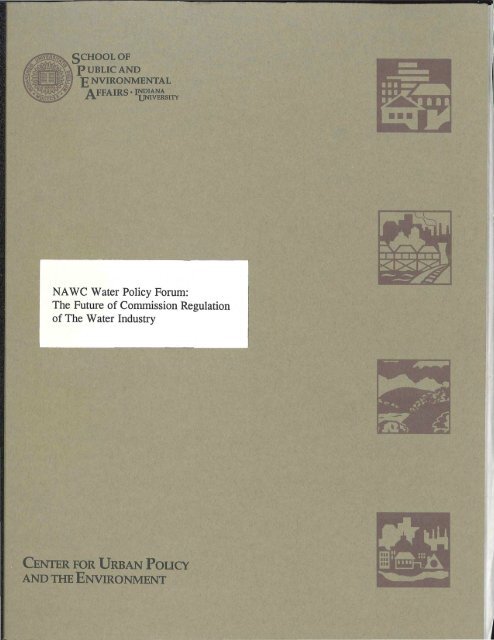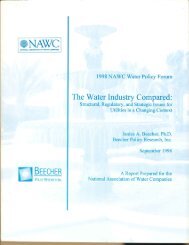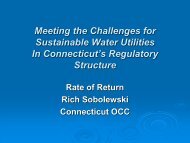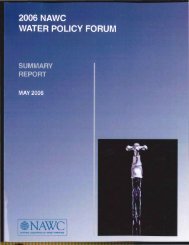CENTER FOR URBAN POLICY AND THE ENVIRONMENT - NAWC
CENTER FOR URBAN POLICY AND THE ENVIRONMENT - NAWC
CENTER FOR URBAN POLICY AND THE ENVIRONMENT - NAWC
You also want an ePaper? Increase the reach of your titles
YUMPU automatically turns print PDFs into web optimized ePapers that Google loves.
NA WC Water Policy Forum:The Future of Commission Regulationof The Water Industry<strong>CENTER</strong> <strong>FOR</strong> <strong>URBAN</strong> <strong>POLICY</strong><strong>AND</strong> <strong>THE</strong> <strong>ENVIRONMENT</strong>
<strong>NAWC</strong> WATER <strong>POLICY</strong> <strong>FOR</strong>UM:<strong>THE</strong> FUTURE OF COMMISSION REGULATION OF<strong>THE</strong> WATER INDUSTRYExecutive Summary andDiscussion PaperbyJanice A. Beecher, Ph.D.September 1996Publication Number 96-E05
..,Indiana University + School of Public & Environmental AffairsCenter for Urban Policy & the Environment1996 <strong>NAWC</strong> WATER <strong>POLICY</strong> <strong>FOR</strong>UMCONTENTSPreface ...................................................................................................... 1. . ..P art1c1pants ................................................................................................. 11Executive Summary ...................................................................................... 111Discussion PaperI. Currents of Change in Public Utilities and Their Regulation Currents ................ 1II. The Value and Price of Water Services .................................................... 5III. The Emphasis on Performance .............................................................. 9IV. The Future of Traditional Economic Regulation ......................................... 12V. Renegotiating the Regulatory Contract ................................................... 15AppendicesA. Restructuring Regulation: Telecommunications .......................................... 20B. Restructuring Regulation: Electricity ...................................................... 21C. Water Utility Regulation: U.S. and Britain Compared .................................. 22
Indiana University + School of Public & Environmental AffairsCenter for Urban Policy & the Environment1996 <strong>NAWC</strong> WATER <strong>POLICY</strong> <strong>FOR</strong>UMPREFACEThe 1996 Water Policy Forum is the second discussion forum convened by the NationalAssociation of Water Companies. The 1996 Forum follows a highly successful inauguralforum held in 1995. The purpose of the Forum is to engage regulators, water industryleaders, and other prominent stakeholders in an open and meaningful dialogue about the waterindustry and its regulation.The theme for this year's forum was The Future of Commission Regulation of the WaterIndustry. The Forum was held September 22-24, 1996. The first full day of the Forum wasdevoted entirely to a relatively unstructured and comprehensive discussion of issues. On thefollowing day, Forum participants reconvened to videotape three discussion sessions designed tocapture highlights of the previous day's discussion. Each session lasted approximately thirtyminutes in length and was organized around one of the three themes selected for the focuseddiscussion at this year's Forum:Session I: Currents of Change in Public Utilities and Their RegulationSession II: The Value and Price of Water ServiceSession III: The Future of Traditional Economic RegulationAlthough participants drew thoughts and perspectives from the preceding day's discussion,the taped sessions were unrehearsed and unedited. An Executive Summary of the Forum isprovided herein.In preparation for the Forum, participants reviewed the discussion paper prepared by Dr.Janice A. Beecher, which follows the Executive Summary. Five topics are addressed in the 1996discussion paper:I. Currents of Change in Public Utilities and Their RegulationII. The Value and Price of Water ServiceIII. The Emphasis on PerformanceIV. The Future of Traditional Economic RegulationV. Renegotiating the Regulatory ContractThe discussion paper provided Forum participants with general background on key issuesand themes. No conclusions or specific recommendations are made. The idea instead was tostimulate the discussion during the Forum and beyond.The National Association of Water Companies and this year's participants consideredthe 1996 Water Policy Forum a great success in providing a unique opportunity to bringimportant issues to light and share ideas from a variety of different perspectives.
Indiana University + School of Public & Environmental AffairsCenter for Urban Policy & the Environment1996 <strong>NAWC</strong> WATER <strong>POLICY</strong> <strong>FOR</strong>UMPARTICIPANTSMr. J. James BarrChainnan of the Board, National Association of Water CompaniesSenior Vice President, American Water Works Service Company, Inc.Dr. Janice A. BeecherSenior Research Scientist and Director of Regulatory StudiesCenter for Urban Policy and the Environment, Indiana UniversityMr. Alan BookerDeputy Director General, Office of Water Services (U.K.)Mr. Peter L. CookExecutive Director, National Association of Water CompaniesMr. Robert A. DolsonFourth Vice President, National Association of Water CompaniesPresident, Continental Water CompanyMr. Ronald S. DunganPresident, National Association of Water CompaniesSenior Vice President, United Water Management and Services, Inc.Commissioner Henry DuqueCalifornia Public Utilities CommissionCommissioner Bruce EllsworthFirst Vice President, National Association of Regulatory Utility CommissionersNew Hampshire Public Utilities CommissionMr. Paul Foran, AttorneyFormer Illinois Commerce CommissionerChair of the Committee on Water, National Association of Regulatory Utility CommissionersMs. Sharon L. GasconDeputy Executive Director, National Association of Water CompaniesMr. Van HoofnagleState Drinking Water Administrator, Florida Department of Environmental RegulationCommissioner Diane KieslingChair of the Committee on Water, National Association of Regulatory Utility CommissionersFlorida Public Service CommissionCommissioner John QuainChainnan, Pennsylvania Public Utility CommissionMs. Melissa StanfordFormer Consumer Advocate for the State of OhioMr. Floyd E. WicksThird Vice President, National Association of Water CompaniesPresident and Chief Executive Officer, Southern California Water Companyii
Indiana University + School of Public & Environmental AffairsCenter for Urban Policy & the Environment1996 <strong>NAWC</strong> WATER <strong>POLICY</strong> <strong>FOR</strong>UMEXECUTIVE SUMMARYSeptember 22, 1996 (Sunday)Welcome and Introduction of the Forum ParticipantsMr. Ron DunganRemarks and OverviewMr. Ronald DunganCommissioner Diane KieslingMr. Paul ForanRoundtable Discussion (All Participants)September 23, 1996 (Monday)The first full day of the Water Policy Forum was devoted entirely to a relativelyunstructured and wide-ranging discussion of issues affecting the public utility industries ingeneral, the water industry in particular, and the future of economic regulation by the statepublic utility commissions. Forum participants were encouraged to explore any and all issuesof concern and express alternative viewpoints. The result was a lively and thoughtfuldiscussion that extended well beyond its scheduled timeframe.Discussion Points• The major characteristics and trends in the water industry, inCluding capital investmentlevels, operating costs, demand factors, revenues, and rates.• Unique characteristics of water service and the water industry compared to other utilityservices and industries.• Differences between publicly and privately owned water utilities.• The major characteristics of the water industry in Great Britain, including regionalizationand nationalization in 1973, privatization in 1989, and the implementation of price-capregulation.• The British approach to quality and performance issues.• Potential competition in the water industry with respect to common carriage (that is,"water wheeling"), acquisitions, contracts for operations, and contestable markets.• Trends in regulation and deregulation in the various states and possible implications for thewater industry.iii
Indiana University + School of Public & Environmental AffairsCenter for Urban Policy & the Environment• Trends in water demand and pricing, and implications of the rise in real water prices (thatis, increases that exceed the rate of inflation).• The specific cost pressures on the water utility industry.• Issues related to competition in the utility sectors, such as consumer choice and utilityincentives.• Incentives for water utilities to hold costs down and perform efficiently.• Whether the U.S. water industry could achieve significant economies of scale and scopethrough consolidation or regionalization (not necessarily with physical interconnection).• The continuing viability problems of isolated small water systems, and the role of largerutilities addressing these problems.• The limitations of mandatory or unfriendly takeovers of small water systems.• The need for and appropriateness of incentives for consolidation (such as acquisitionincentives, single-tariff pricing, and return-on-equity adjustments).• The role of public policy and regulatory policy with respect to structural change in thewater industry, including consolidation and privatization.• The value of water in comparison to other consumer goods and the importance ofeducating customers about water's value.• How cost allocation and rate design for water usually does not consider health and safetyissues (particularly, fire protection), even though these issues drive water utilityspecifications and costs more than water demand.• Reasons for customer frustration with water utilities and rate increases in light of thecommon view that water should be "free."• The impacts of structural and regulatory change on water customers.• Whether the regulatory compact for the water industry was adequate and whether a newmodel was needed.• The need for flexibility and experimentation in developing regulatory alternatives.iv
Indiana University + School of Public & Environmental AffairsCenter for Urban Policy & the EnvironmentSeptember 24, 1996 (Tuesday)Session 1: Currents of Change in Public Utilities and Their RegulationPanelistsDr. Janice A. BeecherCommissioner Henry DuqueCommissioner Bruce EllsworthCommissioner Diane KieslingMr. Ronald DunganMr. Paul Foran, . ModeratorModerator's IntroductionAnyone familiar with the traditional processes and methods of delivering the publicutility services considered essential for economic development and the public health andwelfare cannot help but be aware of the sweeping changes affecting the provision oftelecommunications and energy services in this country.Rapid technological developments, as well as evolving national and internationalpolitical and market changes, have increasingly led governments, legislatures, and policymakers at all levels-in the United States and elsewhere-to conclude that competition andderegulation, in various forms, offer better ways to attain the social and economic goals thatsociety expects to achieve through rate-of-return regulation of essential public utility services.During this first session, the panelists will explore some of the changes occurringacross the country with regard to public utility services and discuss their relevance to andeffects on regulation of water utilities, particularly investor-owned water companies.Discussion Points• Key trends in telecommunications and energy services, and their regulation by the statecommissions.• The underlying technological and economic factors behind the trends toward competitionand deregulation.• Differences between the water utility industry and the other utility industries, as well as theimplications of these differences for alternative regulatory approaches.• Unique aspects of the water sector in comparison to the other sectors (industry structure,capital intensity, technological factors, limits to competition, and rising costs).• Whether changes in the other utility sectors will affect the expectations of water utilitycustomers in terms of performance and price.v
Indiana University + School of Public & Environmental AffairsCenter for Urban Policy & the EnvironmentSession II: The Value and Price of WaterPanelistsCommissioner Henry DuqueMr. Van HoofnagleCommissioner John QuainMs. Melissa StanfordMr. Floyd WicksMr. Paul Foran, ModeratorModerator's IntroductionIt is no secret to economic regulators, water utilities, and certainly water customers,that the prices paid for water services are going up-sometimes way up. Regulatorsincreasingly find themselves considering water utility rate increases, while rates for otherpublic utility services tend to be leveling-off or declining.At the same time, prices might only tell part of the story. Arguably, the value of theproduct that customers receive should be at least as important as the price paid for the service.Customers sometimes are perplexed and upset by the prices they pay for water services,perhaps reflecting an implicit assumption that water is a freely occurring natural resource andthat water prices are not justified. Dr. Jan Beecher, one of the Forum's participants, often hasurged us to think of water as a valued-added commodity as a first step in understanding whyprices for water service may be what they are.During this session, participants explore some of these issues, including what, if any,interrelationships should exist between the price and value of water, especially from aneconomic regulatory standpoint.Discussion Points• Rising water prices, and the implications of price increases that exceed the general rate ofinflation.• Whether water prices actually reflect water's true value, including hidden costs, andwhether water historically has been underpriced.• The relevance of value in setting water prices (for example, the value of fire protection),particularly in the context of public utility regulation.• The roles of water utilities and utility regulators in educating consumers about the value ofwater.• The continuing importance of affordability in light of rising costs and prices, and inrelation to water system viability.vi
Indiana University + School of Public & Environmental AffairsCenter for Urban Policy & the EnvironmentSession III: The Future of Traditional Economic RegulationPanelistsMr. Alan BookerCommissioner Bruce EllsworthCommissioner Diane KieslingCommission 1 ohn QuainMr. J. James BarrMr. Paul Foran, ModeratorModerator's IntroductionOne of the salient issues in public utility regulation for at least the last decade has beenthe quest to develop a better means of providing essential public utility services to customersthan occurs with traditional rate-of-return regulation. Many have criticized the traditionalsystem as fraught with litigation and procedural complexity, and insufficiently responsive torapid technological developments and changing national and international market structures.Alternative approaches run the gamut from relatively minor tinkering with the existing systemto various forms of incentive or performance-based mechanisms to outright deregulation ofpublic utilities.During this session, the panelists will explore some of these issues, especially in thecontext of investor-owned water utilities under the jurisdiction of state economic regulators.Discussion Points• The structure and regulation of the water utility industry in Great Britain.• How expectations of declining water prices in Great Britain compare with expectations ofrising water prices in the United States.• The defining economic characteristics of the water industry and the implications of pricecapregulation.• Whether technological and competitive opportunities in the water sector will be sufficientto warrant deviations from the traditional model of economic regulation.• The importance of achieving service quality at an affordable price for consumers.• The fragmentation of regulatory authority in the water industry.• The role of incentives and profitability in the context of alternative methods of economicregulation.vii
Indiana University + School of Public & Environmental AffairsCenter for Urban Policy & the EnvironmentI. Currents of Change in Public Utilities and Their RegulationThe public utility infrastructure has been an essential part of the American landscape formore than a century. Energy, telecommunications, and water services in the United States havefostered growth, progress, and prosperity and set a standard rivaled around the globe. Over thesame time period, public utility regulation has been a fundamental tool of American public policy.For one hundred years, or so, these institutions generally were very stable. Today, the only realcertainty in the public utility industries and their regulation is change.Public utility services traditionally were considered monopolistic, primarily because ofeconomies of scale in production and delivery and limited opportunities for competition. Today,most utility monopolies are considered "artificial" rather than "natural," meaning that they existnot because of economic necessity but because of deliberate choices on the part of public policymakinginstitutions. In other words, monopolies supposedly are "made" not "born."Technological advances have brought about competitive opportunities in many of thepublic utility sectors. No where is this more apparent than in telecommunications, wherecompetition for long-distance and even local services has emerged. In the natural gas industry,market mechanisms play a central role in determining gas prices and some consumers have directaccess to the marketplace. Markets also are emerging in the electricity sector as experimentationwith retail wheeling begins. The "common carrier" or transportation industry has largely beentransformed to an openly competitive industry.As each of the public utility industries is transformed, so too is the regulatory frameworkunder which they operate. The states, through both legislative and regulatory bodies, are playinga very active role in restructuring the public utility industries. In the telecommunications area, thepace of restructuring has been particularly fast, stimulated in part by a new federal framework formarket reform. Many states have adopted variations of price cap regulation fortelecommunications providers, and local competition is allowed in a majority of the states (seeAppendix A).Regulatory changes also are underway for the electricity industry. A June 1996 report bythe Federal Energy Regulatory Commission (FERC), following a two-year investigation,concluded that deregulation at the retail level was feasible. California is leading the way inimplementing that vision. A 1995 California Public Utilities Commission decision will pave theway for wholesale and retail competition through the establishment of a power exchange, anindependent transmission system operator, and a phase-in plan for retail wheeling. 1 Most of thestate public utility commissions are considering restructuring and deregulation for the electricityindustry; interest in reform is greatest in states where electricity rates are highest. 2 Alternativestructural models for the electric industry are summarized in Table 1. Central to restructuring inthe electric industry is a new emphasis on competitive pricing and performance. 31Barbara R. Barkovich and Dianne V. Hawk, "Charting a New Course in California," IEEE Spectrum 33, no. 7(July 1996): 26-31.2Regulatory Research Associates, as reported in Hunt and Shuttleworth, 23.1
Indiana University + School of Public & Environmental AffairsCenter for Urban Policy & the EnvironmentTable 1Structural Models for the Electricity IndustryElectricityIndustry StructureDefinitionAre therecompetinggenerators?Do retailers havea choice?Do finalcustomers have achoice?MonopolyMonopoly atevery levelNoNoNoPurchasing Agency WholesaleRetail CompetitionCompetitionCompetition among power generators:With single buyer Plus choice for Plus choice fordistributorsconsumersYes Yes YesNo Yes YesNo No YesSource: Hunt and Shuttleworth (1996).The water utility industry long has been considered closest to the concept of a naturalmonopoly because of the industry's high fixed costs and substantial scale economies in sourcedevelopment and treatment. Duplicating facilities for water provision would be highly inefficientand impractical.. In addition, the essential.nature of water (and wastewater) services, as well asthe substantial health, safety, and environmental issues associated with them, have reinforced thelegitimacy of the industry's monopolistic structure at the local level.For a large component of the water industry, the monopolistic nature of water utilities andthe magnitude of the capital needs to build the necessary infrastructure to provide water servicehave been used to justify public ownership. As compared with the other utility industries,municipal ownership prevails in the water sector. Many communities that own their watersystems emphasize the need to control water (and wastewater) services as a means of controllinggrowth and development through annexation. For most publicly owned water systems,government ownership substitutes both for competition and for regulation. Only about a dozenstates regulate publicly owned water systems, and usually on a limited basis. 43However, an interesting trend to watch for in the electricity area is the possibility of "municipalization," or thegreater presence of publicly owned systems in electricity markets. Public power systems could play asignificant role in a more competitive environment as purchasers of power on behalf of communities, and evenas power-pool operators. See Joseph F. Schuler, "A Champion for Public Power," Public Utilities Fortnightly134, no. 13 (July 1, 1996).4In many cases, regulation applies only when the municipality provides service outside of municipal boundaries.Even in these instances, the scope of regulation may not be as extensive for municipal as for investor-ownedsystems. See Janice A. Beecher, 1995 Inventory of Commission-Regulated Water Utilities (Indianapolis: Centerfor Urban Policy and the Environment, 1995).2
Indiana University + School of Public & Environmental AffairsCenter for Urban Policy & the EnvironmentDespite important scientific and technological advances in some areas, such as watertesting and treatment, many of the basic engineering aspects of water supply do not lendthemselves to dramatic change or innovation. Water's physical properties limit the deliverymechanisms to pipes and pumps. Available substitutes for some water uses (such as bottled waterfor drinking) generally will not meet other community needs (such as sanitation or fireprotection). Markets for water are limited by the environmental and economic barriers to waterwheeling. Mixing water from different treatment facilities sometimes can be controversialbecause of concerns about water quality, including liability for quality assurance.Nevertheless, the water industry also is experiencing forms of competition. Water utilitiesgenerally do not compete "head-to-head" for established service territories, although it can beargued that some water markets are "contestable. " 5 The competition for serving new territories ismore evident. For example, multiple utilities in proximity to an available system may bid for theacquisition. The competition for operation and maintenance contracts in the water area alsoappears to be on the rise. Competitors for contracts include utilities, as well as other serviceproviders (such as engineering firms). A more subtle, but important, form of competition isbetween public and private ownership and operations. Public and private utilities both are strivingto provide the best possible service at the lowest cost. With rising cost pressure and constraintson public-sector funding options, however, the interest in involving the private sector in providingwater services may expand.ndgAs long-standing assumptions about public utilities are challenged, so is the long-standingcommitment to ~raditional economic regulatory methods. In the wake of competition, the centralissue for regulation is whether, and when, markets provide consumer choice to a degree thatregulatory protection against the abuse of monopoly power is no longer needed. In response tocompetition in the telecommunications and energy sectors, the scope and methods of economicregulation are being altered in fundamental ways. In fact, a deregulation movement clearly isdetectable.Curiously, but somewhat disheartening, the water utility industry usually is forgotten in thedeliberations over competition and regulatory reform. According to USA Today, "The business ofproviding and selling electricity-th-e USA's one remaining monopoly industry-is being forcedinto the harsh world of competition. " 6 As one member of Congress observed, "Look, we got.through telecommunications [deregulation]. Let's tackle the last surviving monopoly."Evidently, the water industry is not on the monopoly radar screen.A federal policy bias may be behind this misconception. The federal government has hada firm hand in restructuring the telecommunications and energy sectors, through the FederalCommunications Commission (FCC) and the Federal Energy Regulatory Commission (FERC),respectively, and the Congress. No federal agency exerts economic regulatory policy over thewater industry. Absent unprecedented and unanticipated federal intervention, state regulators will5In other words, new entrants might be able to compete for a share of the economic activity once dominatedexclusively by a vertically integrated utility6USA Today, July 16, 1996, lB.3
Indiana University + School of Public & Environmental AffairsCenter for Urban Policy & the Environmentbe on their own to shape the regulatory future of the water industry. 7 It is incumbent on stateregulators to begin addressing the implications of regulatory reform for water utilities.Structural change in the water industry, as in the other utility industries, is underway.However, change in the water industry begins, and may end, in a very different place than itscounterparts. The large number of water providers, the local character of water supply, and thedominance of public ownership distinguish the water industry in fundamental ways. But one wayor another, changes across the regulatory landscape will affect the water utility industry and themanner by which water utilities are regulated. The water industry cannot be isolated from thecurrents of change in regulation. No longer can the architects of regulatory reform neglect theimplications of reform for the water industry. Water utilities, regulators, and the manystakeholders in water supply should begin to engage in a meaningful dialogue about regulatoryreform.Discussion Questions~ What are the key trends in the telecommunications, energy, and water industries? How arethey similar or different?~ Are changes in the structure of the telecommunications and energy industries relevant to thewater industry?• How will regulation of the water industry be affected by changes in the regulation of thetelecommunications and energy industries?7Some federal policies, such as tax and securities policies, will continue to influence the water industry inimportant ways.4
Indiana University + School of Public & Environmental AffairsCenter for Urban Policy & the EnvironmentII. The Value and Price of Water ServiceWater service is a highly essential, if not the most essential public utility service. Water isneeded for drinking purposes, but also for sanitation and fire protection needs. Water serviceembodies significant public health, environmental, and quality of life considerations. Water hasmany purposes, but it is the only utility product consumers actually ingest within their bodies.Customers demand, and regulators require, high standards for water service as measured throughvarious quality, reliability, and aesthetic indicators. Over the long run, the utility is obligated tomeet these standards at a reasonable cost.Water service in many respects is a tremendous bargain. For the price of a gallon ofbottled water at the supermarket, the typical U.S. water customers can turn on the tap and receive500 or more gallons of treated water! 8 Bottled water consumers may value the product for tasteand other aesthetic reasons. But bottled water offers no health or safety advantage, is notregulated for quality control, and is highly impractical for all but drinking and some foodpreparation purposes. Water also is a bargain in comparison to other consumer goods andservices. A favorite comparison among utilities is between water (considered very essential) andcable television (considered very discretionary). Some customers seem more willing to pay forcable television than for water service.Table 2Average Annual Consumer Expenditures, 1994Gasoline and motor oil $986Electricity 861Telephone 690Natural gas, fuel oil, other fuels 381Public transportation 381Alcoholic beverages 278Tobacco products and smoking supplies 259Water and other public services 257Nonalcoholic beverages 233Source: U.S. Department of Commerce, Consumer Expenditure Survey (1994). The survey measures actualexpenditures; some respondents may not have these services and some may not be billed for these services.8For a comprehensive survey of water rates, see Raftelis Environmental Consulting Group, 1996 NationalWater and Wastewater Rate Survey (Charlotte, NC: Raftelis Environmental Consulting Group, Inc., 1996).5
Indiana University + School of Public & Environmental AffairsCenter for Urban Policy & the EnvironmentDelivered water is properly understood as a value-added commodity. Many consumersprobably do not fully appreciate the nature of water service; much of the utility infrastructure isinvisible to the consumer's eye. Although relatively abundant in nature, and seemingly "free,"water's value is enhanced by the source development, treatment, and delivery processes. Utilities·obviously must be compensated for prudent investments made to perform these functions onsociety's behalf.In the developing world, water for drinking and sanitation purposes is a first-orderpriority. In the United States, the high quality of water service easily can be taken for granted.Water and wastewater services are underappreciated in part because they are provided through"invisible networks. " 9 Most of the utility infrastructure is not seen by the customer. Crises thatdisrupt the availability of water (such as a drought), the reliability of water service (such as anearthquake), or the quality of water for drinking (such as a contamination), bring water's value tothe public's attention. ·But the attention span seems short; public support for rate hikes needed tomake improvements-even in the wake of a crisis-can be short lived, especially if the crisissomehow undermines the public's trust in the utility.As a general proposition, water probably has been underpriced relative to its trueeconomic and environmental costs. As a result, consumers probably do not fully appreciate thevalue of water service. In fact, some consumers seem to "resent" paying for water, seeming toview water service as an "entitlement" rather than a consumer good. Customers also will usewater less efficiently than they would if they received an appropriate price signal. Educatingconsumers about the value of water service is perhaps one of the industry's most importantchallenges. A well-educated consumer can become one of the water utility's greatest assets.Water prices are on the rise. The rising price of water may in part be attributed to historicunderpricing. Underpricing may be particularly apparent for publicly owned water systems,where tax revenues, grants, and other subsidies helped keep prices artificially low. Today, waterprices everywhere are under pressure because of the need to replace and improve the aginginfrastructure, meet stringent federal and state drinking water standards, and build capacity tosatisfy demand growth and extend service to new areas. Subsidies, particularly federal and stategrants, are far less available to mitigate rising water utility costs.The effects of these cost pressures can be seen in the Consumer Price Index for water andsewer services, as seen in Figure 1. Until the early 1980s, water prices remained comfortablybelow or near the overall inflation rate. Thus, price increases for water seem to be in keepingwith price increases for other consumer goods and services. Since approximately 1984, water andsewer price increases (that is, real prices) have outpaced inflation.9Ann Durkin Keating, Invisible Networks: Exploring the History of Local Utilities and Public Works. Malabar,FL: Krieger Publishing Company, 1994.6
Indiana University + School of Public & Environmental AffairsCenter for Urban Policy & the EnvironmentRecipe for Rate ShockRate = Costs/Salesif The Numerator (Costs)• Infrastructure replacement• SD W A compliance• New supply development• Efficiency pricing.0. The Denominator (Sales)• Stable per capita use• Slow or no economic growth• Limited expansion opportunities• Increasing end-use efficiencyThe rise in real water prices is a cause of concern toutilities, customers, and regulators. A sudden and sharpprice increase can lead to rate shock for customers. Theproblem of rate shock is further exacerbated by the general·belief that the upward pressure on water costs isaccompanied by constraints on revenue producing unitsales. In other words, the rising costs must be spread overa base that is not keeping pace. Utilities must strive toprovide service at the least possible cost, while meeting allappropriate standards. Ratepayers must strive to keep theirtotal water bill affordable, possibly through conservationmeasures. Regulators must strive to provide appropriateincentives for utility performance, including cost control.From an economic efficiency standpoint, pricingwater at its true economic cost will become increasinglyimportant. Only through efficiency-oriented pricing will customers receive an appropriate signalabout the value of water service, a signal that will allow them to make wise consumption andconservation decisions. Considerable responsibility rests on the water utility and rate regulators(at the state and local levels) to price water service correctly and build customer understanding ofhow that price reflects the value of water service. An added responsibility is to help ensure thatwater service is affordable to the utility's customers.Discussion Questions• Do water customers understand the true value of water service?• What can and should water utilities do to improve ratepayer understanding of the value ofwater?~ How can water utilities and regulators contend with rising water prices and rate shock?7
Indiana University + School of Public & Environmental AffairsCenter for Urban Policy & the EnvironmentFigure 1Consumer Price Index for Water and Sewer Services andGeneral CPE, 1960 to 1995(1982-1984 = 100)8
Consumer Price Index for Water and Sewer Services andGeneral CPI, 1960 to 1995(1982-1984= 100)200.0180.0160.0>
Indiana University + School of Public & Environmental AffairsCenter for Urban Policy & the EnvironmentIII. The Emphasis on PerformanceMarkets provide competitive firms with the "discipline" needed for peak performance,particularly economic efficiency. For utility monopolies, a fundamental purpose of regulation isto ensure performance in the absence of competition. Although essential in the absence ofcompetition, economic regulation is accepted as an imperfect substitute for the marketplace interms of providing performance incentives.The utility industries and regulators increasingly have turned their attention toperformance. Economic pressures and utility regulators have long motivated utilities to considerperformance levels and means of improvement; competitive opportunities are providing new-andmany would argue better-performance incentives for public utilities. Utilities are beginning tocompete on the basis of price and other performance indicators. Regulators can foster a morecompetitive environment, as well as implement variations of performance regulation.Economists and economic regulators are concerned about providing utility servicesefficiently, while also meeting other performance standards. Regulation presumes that a regulatedmonopoly will perform more efficiently than an unregulated monopoly, even though the regulatedmonopoly may not perform as efficiently as a competitive firm. 10 Various standards of reviewhave been developed by regulators to ensure that utility monopolies perform with reasonableefficiency. For example, investments in utility plant must be "used and useful" in order to beincluded in the utility's ratebase. In addition, some regulatory agencies have used financial andmanagement audits to review utility performance. Regulators have tools for rewarding goodperformers, and punishing poor performers; the most powerful, of course, is the rate of return.However imperfect, traditional economic regulation provides utilities with powerful performanceincentives.Despite the good intentions of regulators, and the best available regulatory methods, agrowing sentiment is that utility performance could be improved. As public utility commissionsconsider regulatory reform and alternatives to traditional regulatory methods, the desire to providebetter performance incentives appears to be a high priority. The idea behind incentive regulationis to give utilities more flexibility in meeting performance standards. Highly efficient utilities thatmeet or exceed standards could be rewarded through higher profits. Customers would benefitfrom the utility's higher performance; under some schemes, customers also could benefit througha system of profit sharing. Many states are experimenting with incentive plants as theysimultaneously open the door to competition in the telecommunications and energy industries.The leading indicator of economic performance in the context of either competition orregulation is the unit cost of production (that is, the cost per gallon of delivered water).Differences in costs translate into differences in prices. Comparing prices is irresistible·, eventhough valid reasons for price differentials often apply. For most public utilities, wheredifferentiating service quality is highly constrained, competition on the basis of price seems10An example of an unregulated monopoly is a publicly owned utility not subject to state regulation.9
Indiana University + School of Public & Environmental AffairsCenter for Urban Policy & the Environmentunavoidable. The pressure to keep costs and prices low will continue to mount, possibly to thedettimerit of other policy goals (such as long-term planning and conservation).Of course, utility performance has many dimensions beyond price. Utilities are expectedto perform well according to a broad spectrum of standards for safety, reliability, environmentalprotection, customer satisfaction, and so on. Poor operational performance-failure to complywith health standards, an outbreak of waterborne disease, a service outage, a contaminated source,a high rate of water losses-undermines public confidence in their water and their water provider.Of course, utilities are expected to meet all performance standards efficiently, that is, at the lowestpossible cost.Measuring performance, or benchmarking, is in vogue for many industries, including theutility industries. A utility can use benchmarks as a strategic planning tool to monitor itsperformance over time or make comparisons with other utilities or other firms. Measuringperformance over time can help utilities identify areas of potential improvement and trackprogress toward goals. In some forms of benchmarking, firms "partner" to tackle a specificperformance area (such as customer satisfaction).Performance measurement is difficult from the standpoint that utilities operate underdifferent circumstances, many of which may be outside of the utility's control (such as theavailability and quality of source water). Performance analysts must be careful to control for thekey variables that explain underlying differences in utility performance. Performancemeasurement also is only as good as the available data, which must provide valid and reliablemeasures. As the water industry grows and changes, developing key indicators of performancemay become a priority.Performance benchmarking can be linked to the larger context of the public versus privateownership debate. The privatization movement has stimulated much interest in comparing theperformance of utilities with different ownership forms. In a form of competition, albeitsomewhat limited, utility managers on both sides of the fence are "eyeballing" each other. Forpublicly owned systems, comparisons with other utilities or firms are useful for replicatingmarkets and competition. Many municipal water utilities are using benchmarking as part of"marketization" or "competitivization," sometimes in a defensive strategy to demonstrate thatthey can perform as well or better than privately owned water utilities. For utilities of bothownership forms, in the post-monopoly era, "thinking competitively" is a new skill.The comparison of publicly and privately owned water utilities is greatly complicated bythe fact that most investor-owned water systems and some publicly owned water systems arecommission-regulated. This raises a critical, but often neglected, possibility that efficientperformance by some utilities is as much a product of economic regulation as it is a product ofownership. Whether private ownership without regulation can produce efficiency advantages islargely unknown. 1111Experiments with deregulation in the water sector would make it possible to test this hypothesis. Althoughsome limited examples of deregulation can be found (usually for smaller utilities), a systematic evaluation ofoutcomes has not been conducted.10
Indiana University + School of Public & Environmental AffairsCenter for Urban Policy & the EnvironmentAnother important issue related to performance and regulation is how to coordinate andconsolidate expectations about performance from different regulatory bodies. The statecommissions do not control all aspects of utility performance; nor do they provide the onlyperformance incentives. Consistent performance expectations from different state regulatorswould make it easier for utilities to comply with performance standards effectively and efficiently.With or without overall regulatory reform, performance expectations could be made clearer andmore consistent.The new emphasis on performance is as salient for the water industry as it is for the otherutility industries. For water utilities, improving performance involves formulating strategicresponses to a changing environment. Performance also is intrinsically related to public trust.Customers and regulators will continue to expect a high level of performance from water utilitiesbecause of the essential nature of water service. Water utilities and regulators should engage in adialogue about the appropriate use of performance assessment and incentives in the context oftraditional regulation, as well as in the context of alternative regulatory frameworks.Discussion Questions~ What aspects of water utility performance are most important today?~ What barriers stand in the way of optimal performance by the U.S. water utility industry?~ What performance incentives can economic regulators provide? What disincentives can theyremove?11
Indiana University + School of Public & Environmental AffairsCenter for Urban Policy & the EnvironmentIV. The Future of Traditional Economic RegulationThe century-old traditions of economic regulation are evolving for each of the regulatedindustries. Many states are rapidly moving toward new regulatory models, including deregulationof services when competition is sufficiently established. The traditional ratebase/rate-of-returnform of regulation seems to be waning. A key issue today is whether the traditional model will bepreserved for any of the utility industries, including the water industry. Even though the waterindustry may not exhibit the same pattern of economic or technological evolution as the otherindustries, changes in economic regulation that will affect the water industry seem to beinevitable.One Perspective onPerformance RegulationAccording to a recent Wall Street Journal article,former California regulator Daniel Fessler"predicts that in seven years most Americans willbuy electricity from companies that are regulatedon performance. Argentina's system, whichalready doles out finanCial rewards andpunishments this way, has thus become a windowon the future of the U.S. power industry." TheArgentina model, .in what Fessler calls a "devilishlysimple idea," "Regulators cap rates on what thedistribution companies can charge customers andlet them keep a fat share of what they save belowthe cap. Customers save because the cap istightened every five to eight years, afteradjustments for inflation" (Friedland and Holden,"Power Structure," Wall Street Journal, June 19,1996).regulation provides a means of diffu.sing responsibility for rising rates.A frequent speculation is that waterutilities will be the last of the regulated utilitymonopolies. The relatively few state commissionstaff members working in the water field wonderif someone will "leave the lights on for them," asthe doors to regulation close. Some arguments infavor of maintaining some aspects of traditionaleconomic regulation for water utilities can bemade. Water is a rising-cost industry, so duediligence is required to ensure that investmentsand expenditures are prudent and in the publicinterest. Regulators can use a variety of tools toprovide checks and balances on utilitydecisionmaking. In many respects, utilityregulation legitimizes the ratesetting process. InIndiana, for example, 131 municipal waterutilities are regulated by state commissionvoluntarily. State review helps justify the rate tothe public. For the local elected official, stateAnother argument in favor of economic regulation stems from a frequent criticism of thetraditional ratebase/rate-of-return form. It has been widely held, although sometimes debated,that traditional regulation provides utilities with incentives to overinvest in the utility system inorder to build a rate base on which a return is earned. 12 For the water industry, underinvestmentmay be more of a problem. It is widely held that investment in the nation's water supplyinfrastructure will be greatly needed for replacements, improvements, and extending service intogrowth areas. More private capital, supplied by investor-owned utilities, may be needed in lightof the constraints on public (government) capital. Regulation can help ensure a return onprudently invested capital. Critics could argue, however, that some of the alternatives to rate baseregulation can be designed to provide appropriate incentives for investment as well.12This is known as the Averch-Johnson effect.12
Indiana University + School of Public & Environmental AffairsCenter for Urban Policy & the EnvironmentnersFinally, economic regulation can be used to maintain a degree of monopoly power in thewater sector if monopoly organization is deemed desirable. Monopoly may be desirable from anumber of viewpoints. The substantial fixed costs, long-life assets, and economies of scale inwater supply tend to validate the monopoly form. In addition, water service is considered highly ·essential, with limited opportunities for substitution or duplication of facilities. Water also isintrinsically related to another utility monopoly-wastewater collection and treatment. Water hasstrong public health, safety, and environmental dimensions that justify monopoly, as well asregulation. Finally, the nature of water supply justifies, if not requires, long-term integratedplanning to ensure safe, adequate, and reliable water supplies into the future. The short-termprofitability focus of the competitive environment does not lend itself to the needs of long-termplanning.These arguments in favor of monopoly structure and economic regulation in the waterindustry are valid enough to sustain regulation in the short-term, but probably not in the longterm. Changes in the other utility industries and changes in the water industry will combine tochange the way water utilities are regulated. The traditional model of regulation will beabandoned for competitive utility services and transformed for noncompetitive utility services. Amodel of "structured competition" may emerge for utility services or functions that arecontestable or partially competitive (such as contracts for operation and maintenance services)Changes in the mode of economic regulation have implications for commissionorganization, resources, and culture. Many commissions already have lost substantial numbers ofstaff members to transportation deregulation. Telecommunications and energy staff members areturning their attention (and perhaps their resumes) to competition. Commission staff devoted towater utility regulation, though in the minority numerically, may hold the majority interest intraditional economic regulation, at least for a while.One state commission, the Texas Natural Resource Conservation Commission (TNRCC),is fully devoted to the water industry. The TNRCC has multiple regulatory functions, includingbut not limited to economic oversight. Other states, including Washington, have considered theidea of moving the economic regulatory function to the state agency with primacy for enforcingdrinking water quality regulations. Changes in economic regulation may further consideration oforganizational changes along these lines in order to improve the efficiency of water utilityregulation.Regulators probably are finding it difficult enough to keep pace with the changes underwayin the telecommunications and energy fields. Focusing attention on the water industry can bechallenging, but it is necessary . . A discussion of the implications of regulatory reform for thewater sector cannot be postponed indefinitely.13
Indiana University + School of Public & Environmental AffairsCenter for Urban Policy & the EnvironmentDiscussion Questions~ Can the traditional regulatory paradigm be sustained for the water industry alone?~ Should the states experiment with alternatives to traditional regulation?~ Are alternative regulatory forms appropriate for a monopolistic industry facing rapidly risingcosts?14
Indiana University + School of Public & Environmental AffairsCenter for Urban Policy & the EnvironmentV. Renegotiating. the Regulatory ContractPublic utility regulation is based on an enduring social contract between the government ·and utility companies. In return for having an exclusive franchise, free from "ruinouscompetition," the utility agrees to provide safe, adequate, reliable, and nondiscriminatory servicewithin the boundaries of its service territory and subject utility investments, .rates, and returns toregulatory scrutiny. Several fundamental principles-prudence, used and usefulness, justness andreasonableness-guide utilities and regulators in these endeavors.In the changing environment of public utilities and regulation, the time is right torenegotiate the regulatory contract based on new economic, technological, and public policyconsiderations. The social contract of the past was generic; it applied to all of the public utilitysectors rather uniformly. The new social contract should be industry-specific; the needs andcircumstances of water utilities and their customers should guide policymakers as they draw up amodern social contract for the water industry.Controlling Utility Monopolies:The Fundamental ChoicesPublic OwnershipifEconomic Regulation.0,CompetitionThe traditional social contract is basedon the idea that economic regulationsubstitutes for public ownership on the onehand and competition on the other. Nowhere is this tension clearer than in the waterindustry. A leading structural characteristicof the water industry is the complex andfragmented pattern of ownership. Thiscomplexity is matched in regulation by thedifferent patterns of jurisdiction and authority for the water industry among the states.As summarized in Table 3, with each type of provider (publicly-owned, regulated, andcompetitive) different characteristics and mechanisms apply. For example, albeit anovergeneralization, municipal utilities are accountable to voters, regulated utilities are accountableto ratepayers, and competitive utilities are accountable to customers. Indeed, one sign of thetimes is the growing preference for the term "customer" over the term "ratepayer."Many water utilities welcome the idea of competition, while also being concerned aboutreconciling competition and regulation. When it emerges, competition among utilities providesthe economic discipline that the state no longer must provide through regulation. Competitionrequires willing buyers and sellers for an essentially undifferentiated product, as well asreasonable opportunities for market entry. For economic, technical, and institutional reasons,competition in the water industry may be difficult to realize. As long as monopoly powerpersists, some form of economic oversight is needed to prevent excessive profits and ensureperformance and accountability on the part of the water provider.15
Indiana University + School of Public & Environmental AffairsCenter for Urban Policy & the EnvironmentTable 3A Theory of Providers and PerformanceType of Guiding Focus of · Motivation Mechanism of Mechanism Mechanism forProvider Performance Effort Accountability for Consumer ControllingPrinciple Protection BehaviorPublicly Service Controlling Political Voters Public Elections andowned prices support ownership other politicalprocessesRegulated Prudence Meeting Compliance Ratepayers Regulatory Rules andstandards proceedings regulations'Competitive Eft1ciency Cost control Profits Customers Consumer Markets andchoice competitionSource: Author's construct.Competition in the water industry is perhaps most apparent in the area of contracts. Insome cases, utilities compete for acquisitions of smaller utilities or for extending service into newareas. Although competition for ownership in the water industry may be limited, some watermarkets appear to be contestable in this regard. A leading example is when a municipalityconsiders using powers of eminent domain to "condemn" and take over a water utility. Followingthe acquisition, the same municipality also might entertain competitive bids from alternativeproviders of operation and maintenance services. Among other things, this form of ownershiptransfer often will remove the utility from pubic utility commission jurisdiction.The contestable form competition between publicly and privately owned water utilities isgreatly distorted by the advantages of public sector in terms of tax exemptions, access to capital(including governmental loans and grants), absence of state economic regulation (for the mostpart), and the ability to subsidize the cost of providing water service. These factors combine togive municipalities a competitive advantage, especially in terms of water pricing. In theory, acontestable market provides utilities with performance incentives. Whether or not contestabilitycan provide the same level of discipline as competition or regulation (and substitute for theseinstitutional mechanisms) is not well known. 1313In Kansas, an investor-owned utility is not commission regulated if it serves only within the boundaries of onemunicipality. A "contestability" interpretation of this provision suggests that municipal control and perhaps thethreat of takeover is sufficient for economic regulatory purposes.16
Indiana University + School of Public & Environmental AffairsCenler for Urban Policy & the En vironmenlRegulatory Alternatives• Ratebase/rate-of return (United States)• Price caps (Great Britain, Argentina)• Municipal contracts (France)• Yardstick regulation (Chile)• Regulation by contract, no regulatoryagency (Jamaica)Changes in ownership and operations constitutechanges in the structure of the U.S. water industry.These structural changes suggest that regulatory changesmay be needed as well. A variety of models areavailable for designing a new social contract forregulation. The traditional ratebase/rate-of-returnmodel of economic oversight may not prevail. Thestates have become experimental laboratories for theregulatory alternatives emerging in thetelecommunications and energy sectors. For the watersector, the experimental laboratory is global as countries adapt different regulatory models fornewly privatized water utilities.Most alternatives to traditional regulation emphasize incentives and improving theefficiency of regulatory oversight. In Great Britain, for example, price caps are used inregulating the nation's ten large regional water companies. The many important differencesbetween the U.S. and British experiences may make it difficult to transfer this model to the states(see Appendix C). The large number of U.S . water utilities and the mixture of ownership wouldbe especially problematic in terms of implementing the price cap approach.Some criteria are available for designing an incentive-based plan for regulating publicutilities. These provide crucial guidance in this area: 14• If incentives are used, they should address those aspects of a utility's performancethat are under the control of its management.• The utility should be given a clear expectation as to how its performance under thenew form of regulation will be evaluated and how rewards or penalties will beconferred.• Application of the alternative regulation plan should result in a positive net benefitto the utility's customers and society as a whole.• The information necessary to evaluate the desired behavior should be free fromtampering and ambiguity.• The goal and method of application should have neutral effects and have fewunintended adverse consequences.• The alternative regulation plan should address and eliminate disincentives that existin traditional regulatory practices.Performance assessment could play a role in implementing an incentive plan, as it does inGreat Britain. A few of the regulatory agencies, such as the Washington and Mississippicommissions, have generally considered the use of performance reviews in the context ofregulatory reform. However, no clear model for using benchmarking in regulation has emergedfor the water sector.14William P. Pollard, Rate Incentive Provisions: A Framework for Analysis and a Survey of Activities.(Columbus, OH: The National Regulatory Research Institute, 1981): 55-66.17
Indiana University + School of Public & Environmental AffairsCenter for Urban Policy & the EnvironmentThe social contract for the water industry should consider a number of additional structuralissues and related concerns. A fundamental concern is the uneven playing field between publicand private providers. Public providers have competitive advantages and generally are notregulated by the states. Another issue is the expansion and growth of water utilities into regionalwater service providers. Regionalization offers potential economies of scale and scope to theindustry. Many other considerations, such as watershed protection, also can be addressed moreeffectively at the regional level. If regionalization emerges as a policy goal, barriers to efficientrestructuring and consolidation should be addressed. Apparent agreement about the need toconsolidate water utilities is not always matched by favorable regulatory treatment of acquisitions.Diversification of the water industry into new markets and services, particularly in thewastewater business, also is an emerging issue. A key issue is how regulated utilities can competefor a place in these new markets, either directly or through subsidiaries. A related issue is theexpansion of other industries in the water sector. This may include other public utilities, such asthe electric industry, as well nonutility entities (such as private engineering and operations firms).The important role of water utilities in resource protection and conservation also should beaddressed. Society will continue to expect water utilities to act as conscientious "stewards" ofprecious water resources. This role will become more important as new sources of supply aremore costly to develop. Water utilities and utility regulators also must consider the issues ofaffordability and equity for low-income customers. With rising prices, ability to pay and thethreat of disconnection become major causes of concern.Coordination with other regulators is important for ensuring better utility performance. Inparticular, water quality, quantity, and economic standards set at the state level should be clearand consistent to encourage optimal utility performance. Additionally, positive performanceincentives should be provided through the regulatory process. Utilities that meet standards andrealize efficiencies also should realize the reward for efficient behavior, as in the competitivemarketplace. In some cases, ratepayers should share in these rewards. However, shifting all costsavings to customers leaves little incentive to utilities in terms of performance improvement andinnovation.In sum, a generalized regulatory framework is needed to strike a balance among the needsof the industry, the needs of water customers, and the needs of society as a whole. Optimal longtermsolutions may exact some short-term costs. Regulators must recognize and address thetradeoffs among various policy goals in crafting long-term solutions. Alternative regulatoryframeworks are emerging for the other utility industries, but not yet so for water. Because of itsessential and still rather monopolistic nature, the water industry merits special attention in thecontext of renegotiating the regulatory contract.18
Indiana University + School of Public & Environmental AffairsCenter for Urban Policy & the EnvironmentDiscussion Questions• Is the time right to renegotiate the regulatory contract for the water industry?• Should competition in the water industry be promoted?• Should structural change in the water industry be promoted?19
FIndiana University + School of Public & Environmental AffairsCenter for Urban Policy & the EnvironmentAppendix ARestructuring Regulation: TelecommunicationsPrice Caps (22 states)California../Colorado../DelawareFlorida../Georgia../Illinois../Iowa../Kentucky../Maine../Massachusetts../Michigan../Revenue or Profit-Sharing (3 states)Alabama../MississippiNew JerseyNevada../North DakotaPenns y 1 vania ../Ohio../Oregon../Rhode Island../Tennessee../Texas../Virginia../Wisconsin../South CarolinaBasic and Competitive Service Distinction (17 states)Arizona../MissouriConnecticut../Montana../District of ColumbiaNew York../Hawaii../Utah../IdahoSouth Dakota../Indiana../Washington../KansasWest VirginiaMaryland../Wyoming../Minnesota../Statewide Incentive Plan (1 state)NebraskaTraditional Regulation (8 states)AlaskaArkansasLouisianaNew Hampshire../New Mexico../North Carolina../OklahomaVermontSource: Vivian Witkind Davis, "State Telecommunications Reform on the Eve of Amendments to theCommunications Act," NRRI Quarterly Bulletin 16, no. 3 (Fall 1996) ../ Indicates that local competition allowed.20
Indiana University + School of Public & Environmental AffairsCenter for Urban Policy & the EnvironmentRestructuring Plan Adopted (1 state)CaliforniaAppendix BRestructuring Regulation: ElectricityCompanies Ordered to File a Restructuring Plan (3 states)Massachusetts./New YorkVermontInvestigation Under Way (9 states)Illinois./IowaMaineMichigan./MinnesotaFact-Finding Underway (21 states)AlabamaArizonaConnecticutDelawareDistrict of ColumbiaIdahoIndianaKansasLouisianaMontanaNevadaNo Activity (13 states)ArkansasColoradoFloridaGeorgiaKentuckyMarylandMississippiNew Hampshire./Rhode IslandTexasWisconsinNew JerseyNew MexicoNorth CarolinaOhioOklahomaPennsylvaniaUtahVirginiaWashingtonWyomingMissouriOregonSouth CarolinaSouth DakotaTennesseeWest VirginiaSource: Sally Hunt, "Unlocking the Grid," IEEE Spectrum 33 , no. 7 (July 1996): 23 .../ Indicates that an active pilot program is underway.21
Indiana University + School of Public & Environmental AffairsCenter for Urban Policy & the EnvironmentAppendix CWater Utility Regulation: U.S. and Britain ComparedCriteria I United States I Great BritainGovernment Federal UnitaryImpetus for privatization Pragmatic but increasingly Ideological but increasinglyideologicalcommercialImplementing privatization Bottom-up Top-downWater systems 55,000 Community water 10 Regional water systemssystems formed according to formed according to riverparochial needs basins (nationalized in 1973),and 20 small private systemsUtility ownership 80% Public and nonprofit All privatized ( 1989)20% PrivateRegulatory structure Independent, multimember Single administrator for waterstate commissions with only (OFW AT); othermultisector jurisdiction; limited administrators for other sectorsregulation of publicly ownedsystemsRegulatory authority Quasi-administrative, quasi- Administrative independencelegislative, quasi-judicialRegulatory method Regulatory determination of Regulatory determination ofrevenue requirements,price caps and indexed changesratebase, rate-of-return, and with adjustments for qualityrate designand efficiencyRegulatory review Prudence PerformanceAppeals forum State and federal courts Monopolies CommissionSource: Author's construct.22
Consumer Price Index for Water and Sewer Services andGeneral CPI, 1960 to 1995(1982-1984= 100)200.0180.0160.0~Q)"'0~Q)(.).......HP-4H0s::l~0u140.0120.0I100.080.0 160.0#-~I 1-+-Water CPII~-GeneralCPI40.020.0-0. 0 -1--J-!--f----+- -+--1--+-t---1-t----f--f-----t-1 I .I I 1-t---1-+-+--1--t-l-l- - -- 1---~---+ - - -1 --l-l-l-- - - 1 -N ~ \0 00 0r- r- r- r- 000\ 0\ 0\ 0\ 0\..--1 ..--1 ..--1 ..--1 ..--10 N ~\0 \0 \00\ 0\ 0\..--1 ..--1 ..--1\0 00\0 \00\ 0\..--1 ..--10r-0\..--1YearN000\..--1~000\..--1\0000\..--100000\..--100\0\..--1N ~0\ 0\0\ 0\..--1 ..--1Source: U.S. Bureau of Labor Statistics, published and on-line data sources.
















